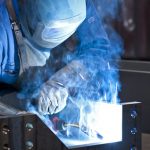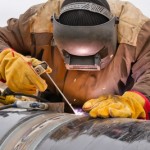Factors for the amount of welding fumes
How much welding fumes created in any welding work depends on many factors: Not only the method and the materials used influence the amount of welding fumes.
The welding fumes emissions, expressed in mg/s, are smaller than the smoke and dust emissions from cutting or spraying as a rule. Studies on this subject show that about 95 percent of the welding fumes originate from welding consumables. The remaining five percent arise from the base material.
The welding process also affects the amount of formation of welding fumes. However, surface coatings and impurities play a role. In addition, there are other factors that must be taken into account.
Current and voltage
Likewise, process and materials apply: The higher the values are for the welding current and welding voltage, the higher is the amount of welding fumes.
Type of current:
Using alternating current results in higher emissions than DC.
Electrodes circumference
The larger the diameter of the electrode used, the higher the amount of welding fumes.
Enclosure type
The substance with which the electrode is sheathed affects the welding fumes: Rutile coated electrodes develop the lowest amount of welding fumes, while the highest amount of harmful substance emissions are produced with cellulose coated electrodes.
Electrode pitch
If the electrode pitch is flat, only small amounts of welding fumes are created than with steeper angles of attack.
Type of weld
If variations of build-up welding is used, higher pollutant emissions occur. With joint welding, the amount, however, is significantly lower.





